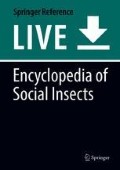References
de Andrade, M. L., & Baroni, U. C. (1999). Diversity and adaptation in the ant genus Cephalotes, past and present. Stuttgarter Beiträge zur Naturkunde, Serie B Geologie und Paläontologie, 271, 1–889.
Powell, S. (2008). Ecological specialization and the evolution of a specialized caste in Cephalotes ants. Functional Ecology, 22, 902–911.
Price, S. L., Powell, S., Kronauer, D. J. C., Tran, L. A. P., Pierce, N. E., & Wayne, R. K. (2014). Renewed diversification is associated with new ecological opportunity in the Neotropical turtle ants. Journal of Evolutionary Biology, 27, 242–258.
Powell, S., Price, S. L., & Kronauer, D. J. C. (2020). Trait evolution is reversible, repeatable, and decoupled in the soldier caste of turtle ants. Proceedings of the National Academy of Sciences of the United States of America, 117, 6608–6615.
Powell, S. (2009). How ecology shapes caste evolution: Linking resource use, morphology, performance and fitness in a superorganism. Journal of Evolutionary Biology, 22, 1004–1013.
Powell, S. (2016). A comparative perspective on the ecology of morphological diversification in complex societies: Nesting ecology and soldier evolution in the turtle ants. Behavioral Ecology and Sociobiology, 70, 1075–1085.
Powell, S., Donaldson-Matasci, M., Woodrow-Tomizuka, A., & Dornhaus, A. (2017). Context-dependent defences in turtle ants: Resource defensibility and threat level induce dynamic shifts in soldier deployment. Functional Ecology, 31, 2287–2298.
Powell, S., & Dornhaus, A. (2013). Soldier-based defences dynamically track resource availability and quality in ants. Animal Behaviour, 85, 157–164.
Adams, E. S. (1990). Interaction between the ants Zacryptocerus maculatus and Azteca trigona: Interspecific parasitism of information. Biotropica, 22, 200–206.
Yanoviak, S. P., Munk, Y., & Dudley, R. (2011). Evolution and ecology of directed aerial descent in arboreal ants. Integrative and Comparative Biology, 51, 944–956.
Coyle, F. A. (1966). Defensive behavior and associated morphological features in three species of the ant genus Paracryptocerus. Insectes Sociaux, 13, 93–104.
Creighton, W. S. (1963). Further studies on the habits of Cryptocerus texanus Santschi (Hymenoptera: Formicidae). Psyche, 70, 133–143.
Sanders, J. G., Powell, S., Kronauer, D. J. C., Vasconcelos, H. L., Frederickson, M. E., & Pierce, N. E. (2014). Stability and phylogenetic correlation in gut microbiota: Lessons from ants and apes. Molecular Ecology, 23, 1268–1283.
Hu, Y., Sanders, J. G., Łukasik, P., D’Amelio, C. L., Millar, J. S., et al. (2018). Herbivorous turtle ants obtain essential nutrients from a conserved nitrogen-recycling gut microbiome. Nature Communications, 9, 964.
Gordon, D. M. (2017). Local regulation of trail networks of the arboreal turtle ant, Cephalotes goniodontus. The American Naturalist, 190, E156–E169.
Powell, S., Del-Claro, K., Feitosa, R. M., & Brandão, C. R. F. (2014). Mimicry and eavesdropping enable a new form of social parasitism in ants. American Naturalist, 184, 500–509.
Author information
Authors and Affiliations
Corresponding author
Editor information
Editors and Affiliations
Rights and permissions
Copyright information
© 2020 Springer Nature Switzerland AG
About this entry
Cite this entry
Powell, S. (2020). Turtle Ants (Cephalotes). In: Starr, C. (eds) Encyclopedia of Social Insects. Springer, Cham. https://doi.org/10.1007/978-3-319-90306-4_131-1
Download citation
DOI: https://doi.org/10.1007/978-3-319-90306-4_131-1
Received:
Accepted:
Published:
Publisher Name: Springer, Cham
Print ISBN: 978-3-319-90306-4
Online ISBN: 978-3-319-90306-4
eBook Packages: Springer Reference Biomedicine and Life SciencesReference Module Biomedical and Life Sciences

